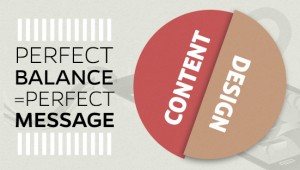Which comes first - content or design? Designers and content developers deal with this question every day.
Whether you are hiring a designer to work on your signage, website, marketing materials, or doing the design yourself, the key to creating an engaging result is understanding how content drives design. Content refers to text copy, imagery, and other media such as audio and video. Design refers to the arrangement of these components in a way which is pleasant or simple to use. 
Common Design and Content Assumptions
We see thousands of examples of content being created and consumed in the digital space. There are two main assumptions being addressed when it comes to content and design.
1. All sites and materials should be similar.
This is not necessarily the case. Remember that there is no one-size fits all solution. This is especially true in digital signage. Some designers use standard style elements for all their clients without considering the content. This might not be the most effective way to attract viewers since the content format and needs of the customer change from project to project. It is important to understand the nature of the content so that it fits the design. No square blocks in round holes.
2. Having content first is not essential to good design.
Sometimes a project must begin before the content is fully developed. By first recognizing essential content elements, such as the objective or scope of the content, designers can create templates and framework for delivering said content before it fully exists. There are well-designed sites which began without any content. Sometimes dummy content can be substituted until the content is ready.
Content Before Design
The simple truth is that viewers come to your website or read your digital signage because of the content, not the layout.
Putting content before the design is the best way to direct the message. Content is the reason that a design should exist in the first place. However, that does not mean the design is not equally important. The point is to understand the best way to use content and design together.
What happens if the content does not fit the design? One option is to start the design from scratch with content and design congruency in mind. Another option is to alter the content to fit the existing design. Otherwise, the content and design may be put at odds with each other, and the result can suffer. Such outcomes can be frustrating and time-consuming to fix. Therefore, it is important to plan for the most intuitive presentation.
Context Matters
There should be cohesion between the content and the design. This is where context plays a significant role. It is the essential step in designing around content. Context refers to the intent of the content, a statement or idea. It allows a more responsive design to be developed. Consider how the audience will view the content and how it should be presented to maximize influence. Ask yourself: What is the message I need to deliver in my content? The answer to this question gives context, and context helps a designer understand how content can be displayed.
Content-Centric Design Strategy
"Content First" is about making content the priority over every other aspect of the design process. By developing content first, you are laying out information, optimizing the space and ensuring that the message reaches the viewers effectively across all devices.
If the design does not match the content's tone, then it will be ineffective, and may even be confusing A design without substance does not get a second look.
Content is important as it communicates a brand's benefit and value to the viewer. The design must be efficient to fit the content properly. It is vital that the design complement the content, surround the message and reinforces the brand.
Here are two best practices:
1. Create user-focused content. Think about your audience or target market. What are their needs? Will the information provide answer their problems? What is the main message you want to communicate? These questions help to organize your message in a way that is easy to understand and gives viewers a positive experience.
2. Understand the content structure. Design a workflow for creating, editing, publishing and managing content. Will this support your brand's message and image? What kind of design elements will you include - text copy, images, video clips, animations, etc.? Are there future content changes that could disrupt this plan?
When a content strategy is formed correctly, you are on the way to producing the best results. A content-centric mindset creates interest more quickly. It converts website visitors into leads and digital signage viewers into customers. It avoids miscommunication that leads to costly design revisions.
The Bottom Line: Make Design and Content Work
Keep in mind that your goal is to deliver information efficiently. Always consider your message, your audience and the best way to communicate your content. Don't allow your content to suffer, nor waste time and money on excessive revisions. Do yourself and/or your designer a favor - create great content and complement it by planning a design to fit said content. Both design and content play a significant role in developing a website, creating signage, and physical materials. One cannot function effectively without the other.
Remember this: Message determines content. Content determines design.
Thus, the elements should work together and complement each other to create an experience which is centered on guiding the reader, client or consumer, through the information you will provide.
